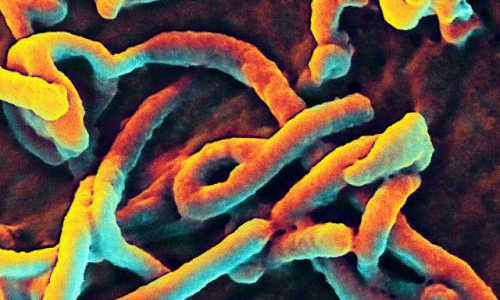Researchers working at Institut Pasteur in France have found that the Ebola virus is mutating “a lot” causing concern in the African countries where the virus has killed over eight thousand people in just several months time. In speaking with the press, they report that multiple mutations of the virus have been observed, though it is still not clear what advantage it has given the virus, if any. They also reported that they have seen many cases of people infected with the virus that did not exhibit any symptoms, which might suggest that at least one of the mutations in the virus has led to infections that are less traumatic to their victim, but which are also likely more easily spread.
A scanning electron micrograph of Ebola virus budding from a cell (African green monkey kidney epithelial cell line). Photo Credit: NIAID
It is not unusual for a virus to mutate, of course, others do it all the time. Also, the Ebola virus is of a class (an RNA virus like HIV and influenza) that is able to evolve via mutations very quickly. The team in France pointed out that the virus has not shown any signs of a change in its mode of transmission—physical contact, which is of course good news—if it became transmissible through the, air for example, it could spread much quicker.
As the virus became evident, first in Guinea then other West African countries, researchers began studying it using techniques such as genetic sequencing which allows for tracking changes in the genetic make-up of the virus. To date, the team has studied approximately 20 samples from people in Guinea and is awaiting the arrival of approximately 600 more samples in the next few months. The World Health Organization reported that a similar study done in Sierra Leone indicated that the virus had mutated a lot in just the first month of the outbreak. It is hoped that such studies will help the medical community keep up with the virus as it changes by helping to diagnose new cases and treat those that are infected.
Meanwhile, officials monitoring the outbreak reported that there were fewer than 100 new cases over a single week period recently, the fewest since shortly after the outbreak began. The WHO also announced that it considers the outbreak to be entering a new phase—the main focus now is ending the epidemic.
Story Source:
The above story is based on materials provided by WHO.





